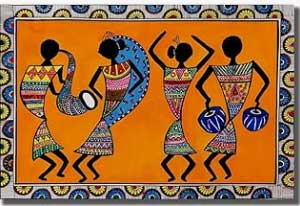Warli art is a tribal art form from Maharashtra, India. It is created by the Warli tribe. This art is known for its simple yet expressive designs.

Image source: Amazon | WA 9990004135 for Art Class | Buy Warli Painting from Amazon
Origin and History
Warli art originated in the Warli tribe in Maharashtra. It dates back to 2500-3000 BCE. The art was traditionally done on walls of huts using natural colors.
The Process
- Preparing the Surface: Artists use a mixture of cow dung and mud to coat the walls.
- Drawing the Design: They use rice paste to draw simple, white geometric shapes.
- Creating Patterns: Circles, triangles, and lines form intricate patterns and scenes.
Themes and Motifs
Warli paintings depict various themes:
- Daily Life: Scenes of farming, dancing, and hunting are common.
- Nature: Trees, animals, and the moon are often included.
- Community: The art shows village life and community activities.
Unique Characteristics
Warli art has special features:
- Simple Shapes: The use of basic geometric shapes is distinctive.
- White on Brown: White designs on a brown background are typical.
- Minimalist Style: The simplicity of the art makes it striking and expressive.
Modern Relevance
Today, this art is popular worldwide. It is used in home decor, fashion, and contemporary art. Many artists are working to keep this traditional art alive.
FAQs
Q1. What is Warli art?
Warli art is a traditional tribal art from Maharashtra, India. It uses simple geometric shapes to depict daily life and nature.
Q2. Where did Warli art originate?
Warli art originated with the Warli tribe in Maharashtra. It dates back thousands of years.
Q3. What materials are used in Warli traditional art?
Artists use a mixture of cow dung and mud for the surface. They draw with rice paste.
Q4. How is Warli traditional art made?
Artists prepare the surface, draw with rice paste, and create patterns using simple shapes.
Q5. What themes are common in Warli traditional art?
Common themes are daily life, nature, and community activities.
Q6. What makes Warli paintings unique?
Warli paintings are unique for their simple shapes, white on brown design, and minimalist style.
Q7. Can Warli traditional art be used for home decor?
Yes, Warli traditional art can be used in home decor, on walls, fabrics, and pottery.
Q8. Where can I buy authentic Warli traditional art?
You can buy authentic Warli traditional art from tribal artists, craft fairs, and online stores.
Q9. How is Warli traditional art being preserved today?
Warli traditional art is preserved through workshops, exhibitions, and by promoting tribal artists.
Q10. Are there modern adaptations of Warli art?
Yes, modern artists create new works inspired by Warli art, blending traditional and contemporary styles.
Conclusion
Warli traditional art is a beautiful and simple tribal art from Maharashtra. Its geometric designs and natural themes make it unique. Supporting Warli traditional art helps preserve this ancient tradition.
View India’s popular art form
- Madhubani Painting: Also called Mithila Painting. Vibrant folk art from Bihar, known for intricate patterns and storytelling.
- Tanjore Painting: Classical South Indian art form renowned for its rich use of gold foil and vibrant colors.
- Kalamkari Painting: Ancient art form from Andhra Pradesh, using natural dyes and intricate storytelling on cloth.
- Mughal Painting: Detailed miniature paintings from the Mughal era, showcasing courtly scenes and historical events.
- Pattachitra Painting: Traditional art form from Odisha, featuring bold lines, vibrant colors, and mythological themes.
- Gond Painting: Tribal art form from Madhya Pradesh, celebrated for its vibrant colors and intricate patterns inspired by nature.
- Rajasthani Miniature Painting: Diverse styles of miniature paintings from Rajasthan, depicting courtly life, landscapes, and religious themes.
- Kerala Mural Painting: Elaborate and colorful murals found in Kerala’s temples and palaces, showcasing Hindu mythology and folklore.
- Thangka Painting: Tibetan Buddhist art form practiced in parts of India, revered for its spiritual significance and intricate details.
- Kangra Painting: Miniature painting style from Himachal Pradesh, known for its romantic themes and delicate brushwork.
- Pichwai Painting: Devotional art form from Rajasthan, depicting Lord Krishna and his various leelas.
- Kalighat Painting: Folk art from Bengal, characterized by simple lines, bold colors, and depictions of everyday life and deities.
- Mysore Painting: Traditional art form from Karnataka, known for its delicate brushwork and intricate details.
